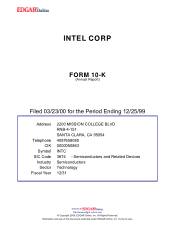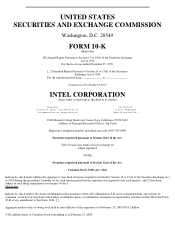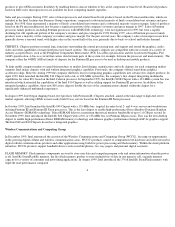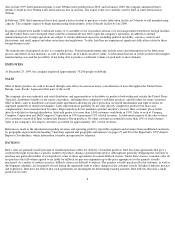Intel 1999 Annual Report Download - page 10
Download and view the complete annual report
Please find page 10 of the 1999 Intel annual report below. You can navigate through the pages in the report by either clicking on the pages listed below, or by using the keyword search tool below to find specific information within the annual report.In October 1999, Intel acquired IPivot, Inc., a designer and manufacturer of Internet commerce equipment. Internet commerce equipment is a
new product category comprising special-function devices that manage information crossing the Internet to help ensure more reliable, faster,
more efficient and secure transactions. In February 2000, the company introduced the family of Intel(R) NetStructure(TM) products, combining
these Internet commerce products with other Intel networking systems.
In September 1999, Intel introduced the Intel(R) 6000 Switch, now incorporated in the family of NetStructure products as the Intel
NetStructure 6000 Switch, and the Intel(R) Express 9500 and 8200 routers. With the addition of these products, Intel has broadened its
networking systems offering to provide medium-size enterprise customers with more flexible and manageable end-to-
end networking solutions.
New Business Group
The New Business Group (NBG) focuses on nurturing and growing opportunities in new market segments, and it positions the company to
serve these emerging market segments. The group provides e-Commerce data center services as well as products such as connected peripherals
and security access software. In 1999, the New Business Group launched Intel(R) Online Services, Inc., providing second-generation Web
hosting and e-Commerce services to companies worldwide. The company opened two Internet service centers--an 85,000-square-foot, major
production facility in Santa Clara, California, hosting more than 10,000 servers, and a development facility in Folsom, California--and has
plans to open centers in Virginia, Japan and England. Second-generation Web hosting includes not only offering customers facilities and
servers but also additional services to help them successfully maintain and grow their e-Business activities.
Other new products in 1999 include the family of Intel(R) Play(TM) toys, and the Intel(R) PC Camera Pro Pack, an affordable and easy-to-use
camera package that includes video phone and video e-mail as well as the capability, through a built-in video capture plug, to bring live or
recorded video into PCs.
MANUFACTURING
A majority of the company's wafer production, including microprocessor fabrication, is conducted at domestic Intel facilities in New Mexico,
Oregon, Arizona, California and Massachusetts. Intel also produces microprocessor- related board-level products and systems at facilities in
Puerto Rico, Oregon and Washington.
A significant and growing portion of Intel's wafer production, primarily wafer production based on the P6 microarchitecture, is conducted
outside the United States at facilities in Ireland and Israel. For the fourth quarter of 1999, wafer production in Ireland was just under 15% of the
company's total wafer production. In June 1999, a new fabrication facility was opened in Israel to manufacture wafers using the 0.18-micron
process technology, primarily for the production of P6 microarchitecture products. Production began at that facility in the second half of 1999
and will continue to ramp toward full production in 2000. Wafer production in Israel is expected to be more than 10% of total wafer production
by the end of 2000. A substantial majority of the company's components assembly and testing, including assembly and testing for processors
based on the P6 microarchitecture, is performed at facilities in the Philippines, Malaysia, Ireland and Costa Rica. The company also performs
components assembly and testing at a facility in the People's Republic of China.
To augment both domestic and foreign capacity, Intel uses subcontractors to perform assembly of certain products and wafer fabrication for
certain components, primarily flash memory, chipsets and networking and communications component products. The company also uses
subcontractors for production capacity of board-level products and systems.
In June 1999, Intel introduced its first microprocessor built using the 0.18-
micron process technology: the mobile Pentium II processor running
at 400 MHz. Intel was the first company in the industry to begin high-volume manufacturing utilizing 0.18-micron process technology. The
0.18-micron process technology features structures that are smaller than 1/500th the thickness of a human hair and smaller than the visible
wavelength of light (for the human eye). Intel's new 0.18-
micron process technology can feature voltages as low as 1.1 to 1.65 volts (the lowest
voltage of the products introduced by Intel as of the end of 1999 was 1.35 volts). In October 1999, the company introduced Pentium III
processors built using the 0.18-micron process technology. The company is manufacturing wafers using the 0.18-micron process technology at
fabrication facilities in Arizona, California, Oregon and Israel.
7























